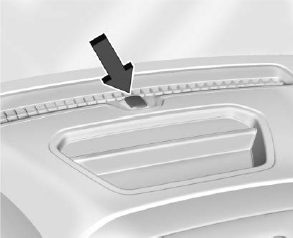Chevrolet Silverado: Vehicle Checks / Battery - North America
The original equipment battery is maintenance free. Do not remove the cap and do not add fluid.
Refer to the replacement number shown on the original battery label when a new battery is needed. See Engine Compartment Overview for battery location.
Stop/Start System
Vehicles equipped with a 2.7L L3B, 3.0L LM2, 5.3L L84 or 6.2L L87 are equipped with a Stop/Start system to shut off the engine to help conserve fuel. See Stop/Start System.
Vehicles with the Stop/Start system have an Absorbed Glass Mat (AGM) 12-volt battery. Installation of a standard 12-volt battery will result in reduced 12-volt battery life. When using a 12-volt battery charger on the 12-volt AGM battery, some chargers have an AGM battery setting on the charger. If available, use the AGM setting on the charger to limit charge voltage to 14.8 volts. Follow the charger manufacturer’s instructions.
Warning
WARNING: Battery posts, terminals, and related accessories contain lead and lead compounds, chemicals known to the State of California to cause cancer and birth defects or other reproductive harm. Batteries also contain other chemicals known to the State of California to cause cancer. WASH HANDS AFTER HANDLING. For more information go to www.P65Warnings.ca.gov/passenger-vehicle.
See California Proposition Warning and the back cover.
Vehicle Storage
Warning
Batteries have acid that can burn you and gas that can explode. You can be badly hurt if you are not careful. See Jump Starting - North America for tips on working around a battery without getting hurt.
Infrequent Usage: Remove the black, negative (−) cable from the battery to keep the battery from running down.
Extended Storage: Remove the black, negative (−) cable from the battery or use a battery trickle charger.
Negative Battery Cable Disconnection
Warning
Before disconnecting the negative battery cable, turn off all features, turn the ignition off, and remove the key, if equipped, from the vehicle. If this is not done, you or others could be injured, and the vehicle could be damaged.
Caution
If the battery is disconnected with the ignition on or the vehicle in Retained Accessory Power (RAP), the OnStar back-up battery will be permanently discharged and will need to be replaced.
- Make sure the lamps, features, and accessories are turned off.
- Turn the ignition off and remove the key, if equipped.
For vehicles equipped with the Stop/Start system:

- Loosen and remove the negative battery cable nut (1) at the battery sensor connection.
- Remove the negative battery cable (2) from the battery sensor stud.
- Cover the negative battery cable terminal, battery sensor stud, and negative battery post with a non-conductive material to prevent any contact with the negative battery cable.
For vehicles not equipped with the Stop/Start system:

- Loosen the negative battery cable nut (1).
- Remove the negative battery cable clamp (2) from the negative battery post.
- Cover the negative battery cable clamp, and negative battery post with a non-conductive material to prevent any contact with the negative battery cable.
Negative Battery Cable Reconnection
Caution
When reconnecting the battery:
- Use the original nut from the vehicle to secure the negative battery cable. Do not use a different nut. If you need a replacement nut, see your dealer.
- Tighten the nut with a hand tool. Do not use an impact wrench or power tools to tighten the nut.
The vehicle could be damaged if these guidelines are not followed.
Caution
Do not use paints, lubricants, or corrosion inhibitors on the nut that secures the negative battery cable to the vehicle. This could damage the vehicle.
For vehicles equipped with the Stop/Start system:
- Install the negative battery cable to the battery sensor stud.
- Install the negative battery cable nut to the battery sensor stud and tighten.
- Turn the ignition on.
For vehicles not equipped with the Stop/Start system:
- Install the negative battery cable clamp to the negative battery post.
- Tighten the negative battery cable nut.
- Turn the ignition on.
 Brake Fluid
Brake Fluid
The brake master cylinder reservoir is filled with GM approved DOT 4 (1500) or
DOT 3 (2500/3500) brake fluid as indicated on the reservoir cap. See Engine Compartment
Overview for the location of the reservoir...
 Four-Wheel Drive
Four-Wheel Drive
Transfer Case
When to Check Lubricant
Refer to Maintenance Schedule to determine when to check the lubricant.
Fill Plug
Drain Plug
To get an accurate reading, the vehicle should be on a level surface...
Other information:
Chevrolet Silverado 2019-2025 Owners Manual: Engine Air Filter Life System
If equipped, this feature provides the engine air filter’s remaining life and best timing for a change. The timing to change an engine air filter depends on driving and environmental conditions. When to Change the Engine Air Filter When the Driver Information Center (DIC) displays a message to replace the engine air filter at the next oil change, follow this timing...
Chevrolet Silverado 2019-2025 Owners Manual: Trailer Towing
If equipped with a diesel engine, see the Duramax diesel supplement. Caution Towing a trailer improperly can damage the vehicle and result in costly repairs not covered by the vehicle warranty. To tow a trailer correctly, follow the directions in this section and see your dealer for important information about towing a trailer with the vehicle...
Categories
- Manuals Home
- 4th Generation Silverado Owners Manual
- 4th Generation Silverado Service Manual
- Engine Compartment Fuse Block
- Power Outlets
- Electric Parking Brake
- New on site
- Most important about car
Vehicle Alarm System

The indicator light, on the instrument panel near the windshield, indicates the status of the system.
